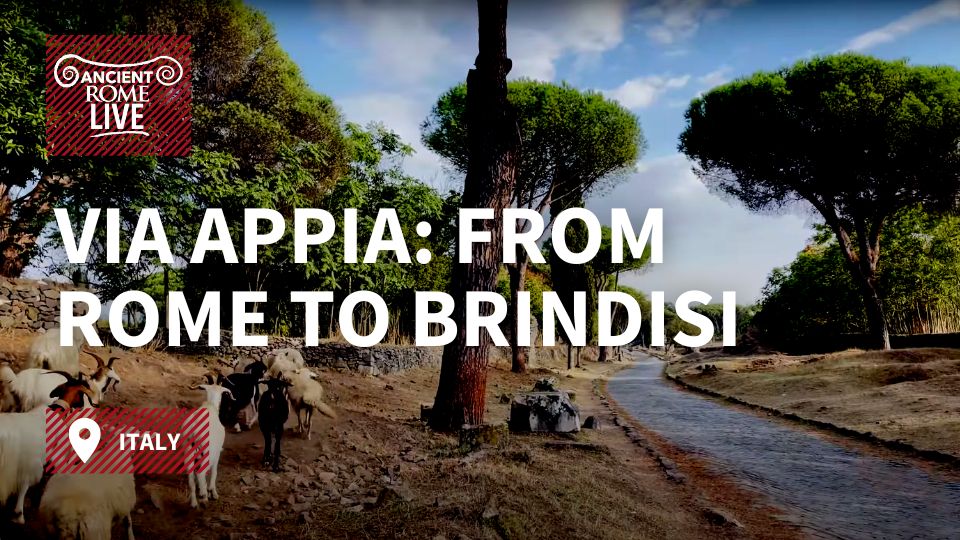Start with our video overview:
Stretching over 500 kilometers, the Via Appia (or Appian Way) is one of Ancient Rome’s most enduring achievements. Built in 312 BCE under Appius Claudius Caecus, this remarkable road connected Rome to southern Italy, revolutionizing both transportation and infrastructure. Initially constructed during the Second Samnite War to move troops into conquered territories, the Via Appia evolved over time into an artery for communication and trade. Today, it stands as a testament to Roman engineering, ambition, and innovation.
All Roads Lead to Rome
Beginning at the Circus Maximus in Rome, the Via Appia embodied the Roman proverb “all roads lead to Rome.” As the central hub of a vast network, Rome eventually oversaw the construction of nearly 80,000 kilometers of roads, extending the reach of the empire to its furthest provinces. Upon its construction in 312 BCE, the Via Appia connected Rome to Capua. As Rome continued to expand, so did the Via Appia. It was extended several times over the centuries, eventually reaching Brindisi under Emperor Trajan. This accomplishment was celebrated with a triumphal arch, which still stands today.
A Marvel of Roman Engineering
What set the Via Appia apart was its durable and straight design. Roman engineers pioneered techniques that ensured longevity, including tightly fitted stone pavements and meticulous grading. Milestones marked distances, offering travelers clear orientation along its length. This meticulous planning not only established the Via Appia as a reliable route, but also inspired road construction practices still in use today.
Monuments
Much of the Via Appia remains visible, with some portions preserved as archaeological parks while others remain in use as roadways. Along the route from Rome to Brindisi, there are many Republican, Imperial, and Christian monuments. These include the monumental tomb of Caecilia Metella, the villa of Maxentius, and several Christian churches and catacombs. The church of Domine Quo Vadis at the second mile marks the location where Saint Peter reportedly had a vision of Jesus. Interpreting the vision as a sign to accept martyrdom, Peter returned to the city and was killed during Nero’s persecution of Christians.
A Road Through Time
The Via Appia is more than just an ancient highway, it’s a narrative thread connecting key chapters in Roman history. From its military origins during the Republic to its integration into early Christian traditions, the road offers a glimpse into the Roman world. Tombs along the route reveal the wealth and status of Rome’s elite, while Christian catacombs chart the transition from hidden beginnings to dominant faith. In 2024, the Via Appia was named a UNESCO World Heritage Site, underscoring its cultural and historical significance.
Experience the Via Appia
Ready to explore this ancient marvel? Watch our eight-part series led by archaeologist Darius Arya as we traverse all 500 kilometers of the Via Appia, from Rome to Brindisi.
Bibliography:
- Anderson, Sonja. “Ancient Rome’s Appian Way Is Now a UNESCO World Heritage Site.” Smithsonian Magazine. https://www.smithsonianmag.com/smart-news/ancient-romes-stone-highway-has-become-a-world-heritage-site-180984788/
- Strochlic, Nina. “A Roman-era ‘superhighway’ is disappearing. Italy has a plan to save it.” National Geographic. https://www.nationalgeographic.com/travel/article/reviving-europes-first-superhighway
- “Via Appia: Regina Viarum.” UNESCO. https://whc.unesco.org/en/list/1708/
This content is brought to you by The American Institute for Roman Culture, a 501(C)3 US Non-Profit Organization.
Please support our mission to aid learning and understanding of ancient Rome through free-to-access content by donating today.
Cite This Page
Cite this page as: Darius Arya, The American Institute for Roman Culture, “Via Appia: Introduction, from Rome to Brindisi.” Ancient Rome Live. Last modified 12/26/2024. https://ancientromelive.org/via-appia-introduction-from-rome-to-brindisi/
License
Created by The American Institute of Roman Culture, published on 11/04/2022 under the following license: Creative Commons: Attribution-NonCommercial-ShareAlike. This license lets others remix, tweak, and build upon this content non-commercially, as long as they credit the author and license their new creations under the identical terms. Please note that content linked from this page may have different licensing terms.



